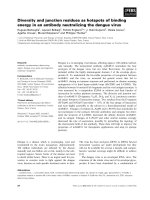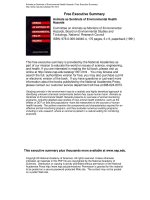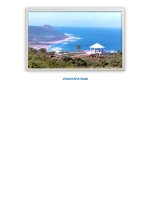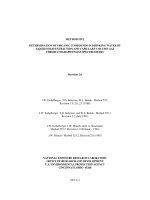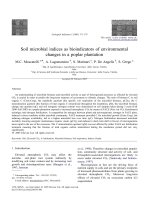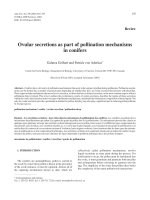- Trang chủ >>
- Khoa Học Tự Nhiên >>
- Vật lý
Palaeolimnological proxies as tools of environmental reconstruction in fresh water
Bạn đang xem bản rút gọn của tài liệu. Xem và tải ngay bản đầy đủ của tài liệu tại đây (0 B, 325 trang )
Palaeolimnological Proxies as Tools of Environmental
Reconstruction in Fresh Water
Developments in Hydrobiology 208
Series editor
K. Martens
Palaeolimnological Proxies as Tools of
Environmental Reconstruction in Fresh Water
Editors
1
Krisztina Buczko´ , Ja´nos Korponai2, Judit Padisa´k3 &
Scott W. Starratt4
1
2
Hungarian Natural History Museum, Department of Botany, 1476 Budapest, P.O. Box 222, Hungary
West-Transdanubian District Water Authority, H-8360 Keszthely, Csik F. str. 1, Hungary; Department of Chemistry
and Environmental Sciences, University of West Hungary, Szombathely, Hungary
Department of Limnology, University of Pannonia, Egyetem u. 10. 8200 Veszpre´m, Hungary
3
4
U.S. Geological Survey, 345 Middlefield Road, Menlo Park, CA 94025, USA
Previously published in Hydrobiologia, Volume 631, 2009
123
Editors
Krisztina Buczkó
Hungarian Natural History Museum
Department of Botany
1476 Budapest
P.O. Box 222
Hungary
János Korponai
West-Transdanubian District Water
Authority
H-8360 Keszthely
Csik F. str. 1
Hungary;
Department of Chemistry and
Environmental Sciences
University of West Hungary
Szombathely
Hungary
Judit Padisák
Department of Limnology
University of Pannonia
Egyetem u. 10. 8200 Veszprém
Hungary
Scott W. Starratt
U.S. Geological Survey
345 Middlefield Road
Menlo Park
CA 94025
USA
Cover illustration: Lake Saint Anna, the only remaining crater lake in the Carpathian Mountains. Other crater lakes were filled
and are now covered by peat-bogs. Photo: Eniko" Magyari.
All rights reserved.
Library of Congress Control Number: 2009934688
DOI: 10.1007/978-90-481-3387-1
ISBN: 978-90-481-3386-4
e-ISBN: 978-90-481-3387-1
Printed on acid-free paper.
© 2009 Springer Science+Business Media B.V.
No part of this work may be reproduced, stored in a retrieval system, or transmitted in any form or by any means, electronic,
mechanical, photocopying, microfilming, recording or otherwise, without written permission from the Publisher, with the
exception of any material supplied specifically for the purpose of being entered and executed on a computer system, for exclusive use by the purchaser of the work.
springer.com
Contents
Foreword: A virtual congress on palaeolimnology—palaeolimnological proxies as tools for environmental
reconstruction in fresh water
K. Buczkó · J. Korponai · J. Padisák · S.W. Starratt 1
Review of dated Late Quaternary palaeolimnological records in the Carpathian Region, east-central Europe
K. Buczkó · E.K. Magyari · P. Bitušík · A. Wacnik 3
Palaeolimnology of the last crater lake in the Eastern Carpathian Mountains: a multiproxy study of Holocene
hydrological changes
E. Magyari · K. Buczkó · G. Jakab · M. Braun · Z. Pál · D. Karátson · I. Pap 29
Subfossil diatoms and chironomids along an altitudinal gradient in the High Tatra Mountain lakes: a multi-proxy
record of past environmental trends
P. Bitušík · V. Kubovc^ík · E. Štefková · P.G. Appleby · M. Svitok 65
Palaeoclimatic signals and anthropogenic disturbances from the peatbog at Nagybárkány (North Hungary)
G. Jakab · P. Majkut · I. Juhász · S. Gulyás · P. Sümegi · T. Töro¡¡csik 87
Late Pleistocene–early Holocene transition recorded in the sediments of a former shallow lake in the Czech Republic
T. Bešta · J. Šafránková · M. Pouzar · J. Novák · K. Nováková 107
A multi-proxy Late-glacial palaeoenvironmental record from Lake Bled, Slovenia
M. Andric^ · J. Massaferro · U. Eicher · B. Ammann · M.C. Leuenberger · A. Martinc^ic^ · E. Marinova · A. Brancelj
121
Lake–peat bog transformation recorded in the sediments of the Stare Biele mire (Northeastern Poland)
M. Ga siorowski · M. Kupryjanowicz 143
Diatoms as a proxy in reconstructing the Holocene environmental changes in the south-western Baltic Sea: the lower
Rega River Valley sedimentary record
A. Witkowski · B. Cedro · A. Kierzek · D. Baranowski 155
Reconstruction of human influence during the last two centuries on two small oxbow lakes near Warsaw (Poland)
L. Galbarczyk-Gasiorowska · M. Gasiorowski · K. Szeroczyn´ska 173
Larval chaoborid mandibles in surface sediments of small shallow lakes in Finland: implications for palaeolimnology
T.P. Luoto · L. Nevalainen 185
Holocene climate on the Modoc Plateau, northern California, USA: the view from Medicine Lake
S.W. Starratt 197
Multiproxy study of anthropogenic and climatic changes in the last two millennia from a small mire in central
Poland
.
M. Lamentowicz · Z. Balwierz · J. Forysiak · M. P1óciennik · P. Kittel · M. Kloss · J. Twardy · S. Zurek · J. Pawlyta 213
Sedimentary multiproxy response to hydroclimatic variability in Lagunillo del Tejo (Spain)
L. Romero-Viana · M.R. Miracle · C. López-Blanco · E. Cuna · G. Vilaclara · J. Garcia-Orellana · B.J. Keely · A. Camacho ·
E. Vicente 231
Basin elevation and salinity changes: late Holocene development of two freshwater lakes at the Karelian White Sea
coast, northwest Russia as reflected in their sediments
M. Dreßler · M. Schult · M. Schubert · J. Buck 247
An approach to the recent environmental history of Pilica Piaski spring (southern Poland) using diatoms
A.Z. Wojtal · A. Witkowski · B. Scharf 267
Diatom-inferred trophic history of IJsselmeer (The Netherlands)
H. Cremer · F.P.M. Bunnik · E.P. Kirilova · E.H.R.R. Lammens · A.F. Lotter
279
Palaeolimnology of Lake Hess (Patagonia, Argentina): multi-proxy analyses of short sediment cores
P. Guilizzoni · J. Massaferro · A. Lami · E.L. Piovano · S.R. Guevara · S.M. Formica · R. Daga · A. Rizzo · S. Gerli
289
A multi-proxy paleolimnological reconstruction of trophic state reference conditions for stratified carbonate-rich
lakes in northern Germany
T. Hübener · S. Adler · P. Werner · M. Schult · H. Erlenkeuser · H. Meyer · M. Bahnwart 303
Foreword: A virtual congress on palaeolimnology—
palaeolimnological proxies as tools for environmental
reconstruction in fresh water
Krisztina Buczko´ Æ Ja´nos Korponai Æ Judit Padisa´k Æ
Scott W. Starratt
Originally published in the journal Hydrobiologia, Volume 631, No. 1, 1–2.
DOI: 10.1007/s10750-009-9805-x Ó Springer Science+Business Media B.V. 2009
The motivation for collecting recent knowledge in a
special issue of Hydrobiologia derives from the
recognition of the importance and applicability of
palaeolimnological tools to help in defining ‘‘reference conditions’’ as designated within the Water
Guest editors: K. Buczko´, J. Korponai, J. Padisa´k &
S. W. Starratt
Palaeolimnological Proxies as Tools of Environmental
Reconstruction in Fresh Water
Dedicated to Olga Sebestye´n (1891–1986), key scientist at the
First Palaeolimnological Symposium, Vice-president of the
SIL (1962–1986).
K. Buczko´ (&)
Department of Botany, Hungarian Natural History
Museum, P.O. Box 222, 1476 Budapest, Hungary
e-mail:
J. Korponai
West-Transdanubian District Water Authority,
Csik F. str. 1, 8360 Keszthely, Hungary
J. Korponai
Department of Chemistry and Environmental Sciences,
University of West Hungary, Ka´rolyi Ga´spa´r square 2,
9700 Szombathely, Hungary
J. Padisa´k
Department of Limnology, University of Pannonia,
Egyetem u. 10, 8200 Veszpre´m, Hungary
S. W. Starratt
U.S. Geological Survey, 345 Middlefield Road,
Menlo Park, CA 94025, USA
Framework Directives and estimating influence of
global climate change on surface waters. This volume
was developed by inviting contributions from prominent experts in their respective fields. The compilation not only presents papers on palaeolimnological
studies, focusing mostly on Eastern and Central
Europe but also includes results from other regions.
The use of palaeoecological analyses of sediments
has a long tradition in Central Europe. In the
nineteenth century, Lajos Lo´czy (1849–1920) organized a systematic scientific research on Lake Balaton, the largest shallow lake of the region, and
published the series of booklets (Lo´czy 1897–1920)
which are considered milestones in the development
of limnology as a separate branch of science and
which are comparable to Forel’s (1841–1912) seminal scientific heritage (Forel, 1892). Another milestone in the development of palaeolimnology was the
first palaeolimnologial meeting which was held in
Hungary in 1967. This meeting included some of the
most prominent limnologists in the world including
G.E. Hutchinson, D.G. Frey (Chairman), Nina V.
Korde, D.A. Livingstone, O. Sebestye´n, and W. Tutin
who together formed the organizing committee. This
committee decided to hold the symposium at the
Biological Research Institute, Tihany, Hungary. The
meeting profited from the excellent facilities and
made the attendance of scientists from socialist
countries possible. This location was also appropriate
in celebrating the long tradition of geological and
limnological studies on the lake including the early
K. Buczko´ et al. (eds.), Palaeolimnological Proxies as Tools of Environmental Reconstruction in Fresh Water.
DOI: 10.1007/978-90-481-3387-1_1
1
K. Buczko´ et al. (eds)
2
effort of L. Lo´czy. Eighty-nine individuals representing 20 different countries were registered at this
symposium (Frey, 1969).
In spring 2008, a large group of scientists
expressed an interest in the present special issue
and 22 manuscripts were submitted, 18 of which are
included in this volume. The primary objective of this
special issue is to present new palaeolimnological
findings from Eastern and Central Europe, as well as
important findings from other regions. Although this
area has sometimes received less attention than other
areas of Europe, the lakes and mires, coupled with the
variability in landscape and the local differences in
climate, provide unique opportunities for studying
palaeolimnology. A review on the Late-Quaternary
records in the Carpathian region provides new results
on the history of a crater lake, Lake Saint Ana, glacial
lakes in the Tatra Mountains and Lake Bled. The
sediments of these lakes, as well as peat bogs, also
provide valuable evidence for studying climate
change.
In the present issue, the various papers provide
new insights on the development of lakes and bogs
during the late-glacial and Holocene, using a wide
range of palaeolimnological proxies, including diatoms, pollen, macrofossils, pigments, Cladocera, and
Chironomidae as well as geochemistry. New results
are also provided from Spain, Finland, Russia, North
America and South America.
The editors express their thanks to Enik}o Magyari
who helped with the editorial work in all of its
phases. Thanks are also due to all the referees for
their efforts in evaluating and improving the manuscripts that were submitted for publication in this
volume.
The guest editors
References
Frey, D. G. (ed.), 1969. Symposium on palaeolimnology.
Internationale Vereinigung fu¨r Theoretische und Angewandte Limnologie Mitteilungen 17. E. Schweizerbartshe
Verlagsbuchandlung, Stuttgart: 448 pp.
Forel, F. A., 1892. Monographie Limnologique. Geneve.
Lo´czy, L., 1897–1920. Ergebnisse der wissenschaftlichen Untersuchungen des Balaton Sees. Magyar Kira´lyi Terme´szettudoma´nyi Ta´rsulat, Budapest.
Review of dated Late Quaternary palaeolimnological
records in the Carpathian Region, east-central Europe
Krisztina Buczko´ Æ Enik}
o Katalin Magyari Æ
Peter Bitusˇ´ık Æ Agnieszka Wacnik
Originally published in the journal Hydrobiologia, Volume 631, No. 1, 3–28.
DOI: 10.1007/s10750-009-9800-2 Ó Springer Science+Business Media B.V. 2009
Abstract The Carpathian Region (including mountains and plains) has for a long time been lacking good
palaeoenvironmental and especially palaeolimnological records, particularly for the Late Quaternary. In the
last two decades, many new sedimentary sequences
were obtained and studied using a wide range of
palaeoproxies. This article reviews results from 123
sequences in the Carpathian Region, all dated by
radiometric methods. Our aim was to pay attention to
the existence of these data; many of them published in
Guest editors: K. Buczko´, J. Korponai, J. Padisa´k & S. W.
Starratt
Palaeolimnological Proxies as Tools of Environmental
Reconstruction in Fresh Water
K. Buczko´ (&)
Department of Botany, Hungarian Natural History
Museum, P.O. Box 222, 1476 Budapest, Hungary
e-mail:
E. K. Magyari
Hungarian Academy of Sciences, Palaeonthological
Research Group, Hungarian Natural History Museum,
P.O. Box 222, 1476 Budapest, Hungary
national periodicals and journals. Palaeoenvironmental
records with at least two proxies and with palaeolimnological interpretation were compiled in both tabular
form and on maps. Inspite of the density of examined
sites, an assessment of the dataset led us to the following
conclusions: (1) very few provide firm hydrological–
limnological interpretation, such as lake level and mire
water-depth fluctuation, lake productivity changes and
pH changes; (2) only 47 of them are real multi-proxy
studies (have at least two proxies employed on the same
sediment core); (3) glacial lakes in Slovakia and
Romania as well as in Ukraine are seriously underinvestigated although they would be ideal objects of
palaeolimnological works with the many proxies applicable on them; (4) the Hungarian lowland areas are
dominated by shallow tectonic lakes or palaeochannels,
often with unsatisfactory preservation of certain biological proxies (e.g. diatoms, chironomids, cladocerans). Consequently, palaeolimnological studies from
this region have to apply a different combination of
proxies and approach than mountain lake studies.
Keywords Palaeolimnological records Á
Multi-proxy Á Carpathians Á Pannonian Plain Á
Late Glacial Á Holocene
P. Bitusˇ´ık
Research Institute & Faculty of Science, Matthias Belius
University, 974 01 Banska Bystrica, Slovakia
Introduction
A. Wacnik
W. Szafer Institute of Botany, Polish Academy of
Sciences, Lubicz 46, 31-512 Krako´w, Poland
In recent years, significant progress has been made on
continental scale quantitative climate reconstructions
K. Buczko´ et al. (eds.), Palaeolimnological Proxies as Tools of Environmental Reconstruction in Fresh Water.
DOI: 10.1007/978-90-481-3387-1_2
3
K. Buczko´ et al. (eds)
4
for the Last Glacial Maximum, Late Glacial and
Holocene periods (Harrison et al., 1996; Peyron et al.,
1998; Davis et al., 2003; Magny et al., 2003). These
European reconstructions using pollen and lake-level
records provided a basis for (1) model-data comparison, (2) assisted in our understanding of ecosystem
response to orbital forcing and (3) highlighted
important latitudinal and longitudinal differences in
the direction of climate change at short-lived abrupt
climatic oscillations, such as the perturbations of the
North Atlantic thermohaline circulation (Alley et al.,
1997) and changes in past solar activity (Bond et al.,
2001). Looking at the data point distribution of these
continental scale reconstructions, a salient feature is
the scarcity of data points in the east-central European
sector, and particularly in the Carpathian Region. One
reason for this data shortage is the general scarcity of
potential sedimentary sequences suitable for multiproxy analyses in the Carpathian Basin. The other
reason is the former political–social division of
Europe that resulted in the publication of several
east-central European Late Quaternary palaeoenvironmental and palaeolimnological studies in national
periodicals and journals sometimes of lower scientific
quality. As a consequence, the data of the local
scientific groups have been buried and disappeared
like ‘fossils in the sediment’.
In order to the increase the awareness of existing
Late Quaternary palaeoenvironmental/palaeolimnological studies from the Carpathian Region as well as to
turn scientists’ interest towards potential sites, an
attempt is made in this study to collect, tabulate and
map dated palaeolimnological sequences. Late Quaternary records with at least two proxies (of which at
least one is biological), and multiple 14C or 237Cs
isotope dates were included. Records with an exclusive emphasis on terrestrial vegetation development
were excluded, as these cannot be used to infer the
status and changes of water bodies. Our aim was to
summarize the available proxy records from this
region to make them available for regional and
European-scale Late Quaternary hydrological and
palaeoclimate reconstructions.
The need for the construction of European scale
palaeolimnological databases has long been stressed
(e.g. Batterbee et al., 2007, 2009), and several
databases came into existence as outcomes of large
European projects. The first attempt goes back to
1976, when IGCP Project 158 (‘Palaeohydrology of
the Temperate Zone During the Last 15,000 Years’)
was launched (Berglund, 1986). This was followed
by the ELSDB (European Lake Status Data Base; Yu
& Harrison, 1995), ELDP (European Drilling Programme, Brauer & Negendank, 2004) databases, and
most recently, by the compilation of the Metadatabase (Battarbee et al., 2007, 2009). In addition, a
valuable data source is the European Pollen Database
(EPD). These databases include some of the records
described in this study, but the majority of them are
summarized in this study for the first time.
Study sites
Situated in east-central Europe, the Carpathian
Region is a well-defined geographical unit bordered
by the curved ranges of the Carpathians to the north
and east (Fig. 1). They encompass a vast lowland
area called the Pannonian Plain that is the second
major part of the geographical unit (Fig. 1). Apart
from the highest peaks, this area has never been
glaciated. During the last glacial period (Wu¨rm or
Weichselian), the Carpathian Region fell into the
periglacial zone with southward diminishing influence of the European ice sheet. The lack of glaciation
means that lakes and mires are relatively few in this
region, especially in the lowland. A concentration of
lakes, however, appears in the glaciated mountain
chains—e.g. the Retezat Mts have 58 (Clarke et al.,
2005), the Tatra Mts have 138 major lakes ([0.01 ha)
and 11 lakes are located in the Ukrainian part of the
Carpathians (Pokyncˇereda, pers. com.).
Methods
The data were collected from all available literature.
In addition, the EPD and the Meta-database (Battarbee et al., 2007) were used. Where research results
were published in pieces or at different level of
completeness, only the most comprehensive studies
were cited. Sediment chronologies are mainly based
on 14C measurements, but different authors treat these
dates in various ways; for example, some provide
calibrated radiocarbon timescale, while others present
the data along depth or uncalibrated radiocarbon
timescale. In order to make these records comparable,
we decided to present the depth of the lowermost 14C
Fig. 1 Dated Late Quaternary palaeolimnological records in the Carpathian region, east-central Europe. The first letter of the locality refers to the country, C as Czech Republic,
P as Poland, S as Slovakia, H as Hungary and R as Romania. For location details, see Table 1
Palaeolimnological Proxies as Tools of Environmental Reconstruction in Fresh Water
5
K. Buczko´ et al. (eds)
6
date and the uncalibrated 14C value. In addition,
where possible, calibrated age ranges of the sedimentary sequences were also displayed according to
the original publications. If the original publication
contained only uncalibrated age ranges, then the
CalPal-2007Hulu calibration dataset (Weninger &
Jo¨ris, 2008) and the CalPal-2007Online program
(Danzeglocke et al., 2008) were used to obtain the
calibrated age ranges. An asterisk marks these
records after the calibrated age range. This way, all
the records have calibrated age ranges that make
them easily comparable.
The criteria for inclusion of a site/record were as
follows:
(1)
(2)
(3)
(4)
the sediment is of Late Quaternary age;
it has been dated by radiometric methods;
published studies include palaeolimnological
inferences;
at least two proxies were analyzed.
Even though national and international journals
were screened carefully for Late Quaternary studies,
and experts were also asked to check the database,
some sites fulfilling these criteria may have been
omitted. We apologize authors whose data were not
found.
Results
Altogether, 110 localities are listed in Table 1
including 123 sequences. Six sequences can be found
in the Czech Republic, 15 in Slovakia, 38 in Poland,
37 in Hungary and 24 in Romania. The distribution of
dated Late Quaternary sequences is presented on the
relief map of the Carpathian Region (Horva´th &
Bada, 2008).
The time resolution and the number of palaeoproxies applied on these sediments vary considerably
between sites (Table 2). Most of them cover the
Holocene (63), but the number of Late and Full
Glacial records is also significant (55). The longest
continuous sequence comes from the Romanian
Carpathians (Iezerul Caliman); here, pollen and
lithological analyses extend back to ca. 17,700
cal year BP (Fa˘rcas¸ et al., 1999, 2003, 2006a, b;
Feurdean et al., 2007a). Most of the sediments
analyzed from this region are peat, and only 15 lake
sites are known with continuous lake deposits all over
the sequence (Taul dintre Brazi, Taul Zanogutii,
Pesteana, Saint Ana, Lake Balaton, Bala´ta-to´, Vysˇne´
Temnosmrecˇinske´ pleso, Vysˇne´ Wahlenbergovo pleso, Nizˇne´ Terianske pleso, Lˇadove´ pleso, Zielony
Staw Ga˛sienicowy, Czarny Staw Ga˛sienicowy, Toporowy Staw Wy_zni, Długi Staw, Przedni Staw).
Sediment lithology was published from 104 sites;
pollen analysis was done on 115, plant macrofossil on
33 and diatom analysis on 13 sequences. Twenty-one
sites have malacological records, cladocera were
analyzed at seven sites, and merely three sites have
chironomid or testate amoebae records. Geochemical
records are available from 17 sediment sequences,
LOI was measured in 20 cases, and archaeological
data supplemented the palaeoenvironmental reconstruction at 28 localities. Late Quaternary ostracod
records were not found in the region.
In some cases, information can be found on the
geomorphology, granulometric indexes, grain size
distribution of mainly minerogenic deposits, green
algae and bryophyte components of the sediment.
Chrysophycean cysts were recorded only occasionally (two sites), as well as pigments and spherical
carbonaceous particles (SCP).
The highest number of proxies (eight) was
analyzed on the Holocene sediment sequence of
Lake Saint Ana (Eastern Carpathians; Magyari et al.,
2006, 2009a). In addition, the best studied lake
deposit of the Western Carpathians is Nizˇne´ Terianske pleso, where altogether eight different proxies
were studied, however, on different occasions and
sediment cores (Sˇporka et al., 2002; Appleby &
Piliposian, 2006; Markova´ et al., 2006; Bitusˇ´ık et al.,
2009). The number of radiocarbon dates and time
resolution of the various proxies are also the highest
at Nizˇne´ Terianske pleso (Appleby & Piliposian,
2006; Bitusˇ´ık et al., 2009). Localities that were
studied by multi-proxy methods and obtained useful
evidence for hydrological changes are indicated by
asterisk on the map (Fig. 1).
Discussion
The study of Late Quaternary vegetation dynamics
have a long tradition in the Carpathian Region, but
only recent studies provided radiocarbon-dated and
high-resolution vegetation records using pollen and
plant macrofossil analyses (e.g. Fa˘rcas¸ et al., 1999,
C5
P2
Jasło-Sanok Depression, Poland
P7
Tarnawa Wy_zna
P6
Jasło-Sanok Depression,
TARW-N, Poland
Tarnowiec
Bieszczady Mts, TAR1_N, Poland
Roztoki
Jasło-Sanok Depression, ROZ14A-N,
ROZ1B-N, Poland
Lower Beskid Mts, Poland
Jasiel
P5
P4
Jasło
21°370 000
22°490 000
49°090 000
49°420 000
21°350 000
21°530 1300
21°280 000
21°420 000
19°490 000
17°570
17°100 000
49°430 000
49°220 2200
49°470 000
49°320 000
Orawa-Nowy Targ Basin,
PUREK_N, Poland
Cergowa Go´ra
P1
P3
49°290 000
Moravskoslezske´ Beskydy,
Czech Republic
Pus´cizna Re˛kowian´ska
Lower Beskid Mts, Poland
49°230
Jablunka
C6
Pannonian lowland, Czech Republic
48°500 000
Pannonian lowland, Czech Republic
Svatoborˇice-Mistrˇ´ın
17°120 1000
48°580 4000
Vracov
17°020 2500
C4
C3
48°490 3000
18°370 5300
49°310 1400
Za´padne´ Beskydy, Czech Republic
Machova´
Moravskoslezske´ Beskydy,
Czech Republic
18°010 4000
49°070 5500
Kra´lovec
Bile´ Karpaty, Czech Republic
Hornı´ Lomna´
C1
C2
Longitude
Latitude
Site name
Details the locality of core, Country
Map
code
220
670
230
680
250
495
656
350
175
192
460
615
560
Alt
(m)
253
705, 265–700
463–585,
340–535
245
400
550
732
28 hiatus
235
270
100
100
125
Record
length (cm)
Lithology, pollen
Lithology, pollen, macrofossil
Lithology, pollen, mollusc
Lithology, pollen
Lithology, pollen
Lithology, pollen, macrofossil,
archaeology
Lithology, pollen
Pollen
Pollen, archaeology
Pollen, macrofossil
Pollen, macrofossil
Pollen, macrofossil
Pollen, macrofossils,
malacology
Proxies
Harmata (1987, 2008)
Ralska-Jasiewiczowa (1972, 1980)
Harmata (1987)
Szczepanek (1987)
Szafer (1948), Alexandrowicz (1984a, b),
Harmata (1995)
Wie˛ckowski & Szczepanek (1963),
Budziszewski & Skowronek (2001),
Pazdur (2001), Szczepanek (2001a, b)
Obidowicz (1990, 1993, 1996)
Jankovska´ & Pokorny´ (2008), Kunesˇ
et al. (2008)
Svobodova´ (1989)
Rybnı´cˇkova´ & Rybnı´cˇek (1972)
Rybnı´cˇkova´ et al. (2005)
Horsa´k & Ha´jkova´ (2005), Rybnı´cˇkova´
et al. (2005)
Rybnı´cˇkova´ et al. (2005)
References
Table 1 Locality details and studied proxies of dated Late Quaternary palaeolimnological records in the Carpathian region, east-central Europe
Palaeolimnological Proxies as Tools of Environmental Reconstruction in Fresh Water
7
P20
Beskid S´redni Mts, Poland
Hajduki
49°470 3000
49°460
P19
Beskid Makowski Mts, Poland
49°310 5100
_
Beskid Zywiecki
Range, Poland
Koton´
49°490
49°450
49°460 2000
49°470 1900
49°460 2000
49°460
49°460
49°430 1600
Pilsko
Beskid Makowski Mts, Poland
Kamiennik
Beskid Makowski Mts, Poland
Pcim Krzywica
Beskid Makowski Mts, Poland
Mirkowo
Beskid Makowski Mts, Poland
Sio´dmowo
Beskid Makowski Mts, Poland
Pe˛kalo´wka
Beskid Makowski Mts, Poland
Zie˛by
Beskid Makowski Mts, Poland
Bogdano´wka-Beło
Beskid Makowski Mts, Poland
Osieczkowa
P18
P17
P16
P15
P14
P13
P12
P11
P10
Beskid Makowski Mts, Poland
19°590 2300
19°540
19°190 1300
20°000
19°570
19°570 3000
19°570 3000
19°540 5000
19°470
19°460
19°470 0800
19°280
49°430
Lower Beskid Mts, SZYM_N, Poland
_
Zurawica
P9
21°060 000
49°380 000
Szymbark
P8
Longitude
Latitude
Site name
Details the locality of core, Country
Map
code
Table 1 continued
475
740
1,270
587
460
443
507
685
535
675
650
575
465
Alt
(m)
330 hiatus
470 hiatus
390 hiatus
450
160
250 hiatus
150 hiatus
175 hiatus
150 hiatus
500 hiatus
140 hiatus
650 hiatus
485
Record
length (cm)
Lithology, pollen, LOI,
geomorphology, granulometric
indexes, grain size
Lithology, pollen, macrofossil, LOI,
geomorphology, granulometric
indexes, grain size
Lithology, pollen
Lithology, pollen, LOI,
geomorphology, granulometric
indexes, grain size
Lithology, LOI, geomorphology,
granulometric indexes, grain size
Lithology, pollen, LOI,
geomorphology, granulometric
indexes, grain size
Lithology, pollen, LOI,
geomorphology, granulometric
indexes, grain size
Lithology, pollen, LOI,
geomorphology, granulometric
indexes, grain size
Lithology, pollen, LOI,
geomorphology, granulometric
indexes, grain size
Lithology, pollen, LOI,
geomorphology, granulometric
indexes, grain size
Lithology, pollen, LOI,
geomorphology, granulometric
indexes, grain size
Lithology, pollen, LOI,
geomorphology, granulometric
indexes, grain size
Lithology, pollen
Proxies
Margielewski &
Zernitskaya (2003),
Margielewski (2006)
Margielewski et al. (2003)
Obidowicz (2003)
Margielewski (2006)
Margielewski (2006)
Margielewski (2006)
Margielewski (2006)
Margielewski (2006)
Margielewski (2006)
Margielewski (2006)
Margielewski (2006)
Margielewski (2006)
Gil et al. (1974),
Szczepanek (1989)
References
8
K. Buczko´ et al. (eds)
49°130
Tatra Mts, Poland
Wy_zna Pan´szczycka Młaka
P24
49°050
Tatra Mts, Poland
Krzemien´
P26
P35
P34
P33
P32
P31
P30
Beskid Wyspowy Mts, Poland
Sowliny (near Limanowa)
Jasło-Sanok Depression, Poland
Jasło Bryły
Pieniny Mts, Poland
Harcygrund valley (near Czorsztyn)
Pieniny Mts, Poland
Piwniczna-Podolik
Upper Vistula valley, Poland
Drogomys´l
Bieszczady Mts, Smerek
I, II, III, Poland
Klaklowo (near Stro´z_ a)
Beskid S´la˛ski Range, Poland
Smerek
49°430 2600
49°450 4100
49°260
20°240 5200
21°260 1500
20°190
20°430
18°450
49°520
49°250
19°540
22°260
22°420
22°430
22°440
15°500 3500
20°020
20°010 0700
20°000 3300
20°040 1900
Longitude
49°470
49°110
P28
P29
49°050
Bieszczady Mts, Poland
Szeroki Wierch
Bieszczady Mts, Poland
49°040
Tarnica
P27
Bieszczady Mts, Poland
49°120 3800
Siwe Sady
P25
Tatra Mts, Poland
49°130 4900
Czarny Staw Ga˛sienicowy
49°130 4300
P23
Tatra Mts, Poland
Zielony Staw Ga˛sienicowy
Tatra Mts, Poland
49°120 0700
_
Zabie
Oko
P21
P22
Latitude
Site name
Details the locality of core, Country
Map
code
Table 1 continued
410
230
520
360
ca.
300
480
600
1,170
1,230
1,300
1,542
1,345
1,620
1,671
1,390
Alt
(m)
20
ca. 120
20
ca. 150
60 hiatus
360
290
11
5
97
70
550
200
235
481
Record
length (cm)
Lithology, pollen, macrofossil,
mosses
Lithology, pollen, mollusc,
geomorphology
Lithology, mollusc,
geomorphology
Lithology, mosses, mollusc,
geomorphology
Lithology, pollen, macrofossil,
geomorphology
Lithology, pollen, LOI,
geomorphology, granulometric
indexes, grain size
Lithology, pollen, macrofossil
Pollen
Pollen
Lithology, pollen, mosses
Lithology, pollen
Lithology, pollen, mosses
Lithology, pollen
Lithology, pollen
Lithology, pollen, macrofossil,
green-algae
Proxies
Alexandrowicz et al. (1985),
Mamakowa and Wo´jcik (1987),
Alexandrowicz (1988)
S´rodon´ (1987), Alexandrowicz (1988)
Alexandrowicz (1984a, b)
Alexandrowicz (1985)
Niedziałkowska et al. (1985)
Margielewski (2001)
Ralska-Jasiewiczowa (1972, 1980,
1989)
Ralska-Jasiewiczowa et al. (2006)
Ralska-Jasiewiczowa et al. (2006)
Ralska-Jasiewiczowa et al. (2006)
Obidowicz (1996)
Obidowicz (1996)
Obidowicz (1996)
Obidowicz (1996)
Obidowicz (1996), Wołowski et al.
(2002)
References
Palaeolimnological Proxies as Tools of Environmental Reconstruction in Fresh Water
9
S10
S9
Tatra Mts, Slovakia
Bobrov
Oravska´ kotlina, Slovakia
Trojrohe´ pleso
19°340
20°150
49°270
49°140
18°400 2000
19°160
S7
17°530 1600
20°100 0400
20°090 4600
20°000 5100
20°010 3700
20°020 2200
20°02
20°010 7000
49°290
49°290 0300
Biele Karpaty, Slovakia
Kubrı´kova´
S6
S8
48°530 1800
Tatra Mts, Slovakia
Tlsta´ Hora
Za´padne´ Beskydy, Slovakia
Dolina Zlatne´ho potoka
Podbeskydska´ bra´zda, Slovakia
49°110 4800
Starolesnianske pleso
Tatra Mts, Slovakia
Lˇadove´ pleso
S5
S4
49°110 0200
S3
S3
49°100 1100
Tatra Mts, Slovakia
Nizˇne´ Terianske pleso
Tatra Mts, Slovakia
49°090 5100
49°110 2000
49°120
49°220 7300
20°0200
49°160
Vysˇne´ Wahlenbergovo pleso
Tatra Mts, Slovakia
Vysˇne´ Temnosmrecˇinske´ pleso
Tatra Mts, Poland
Przedni Staw
Tatra Mts, Poland
Długi Staw
Longitude
Latitude
S2
S1
S1
P38
P37
Toporowy Staw Wy_zni
P36
Tatra Mts, Poland
Site name
Details the locality of core, Country
Map
code
Table 1 continued
1,650
640
900
790
460
1,988
2,057
1,940
2,157
1,725
1,668
1,784
1,024
Alt
(m)
210
230
350
100
290
16
30
Kajak
sampler
30
35
Kajak
sampler
30
308
Kajak
samples
600
Record
length (cm)
Pollen
Pollen
Pollen
Pollen, macrofossil
Pollen, macrofossil, mollusc
Cladocera, chironomid
Cladocera
Cladocera
Diatom, geochemistry,
chironomid, LOI, cysts,
pigment, Spheroidal
Carbonaceous Particle
Diatom, chironomid, LOI
Cladocera
Diatom, chironomid, LOI
Lithology, pollen, diatom,
cladocera, geochemistry
Cladocera
Lithology, pollen, mosses
Proxies
Hu¨ttemann & Bortenschlager (1987)
Rybnı´cˇek & Rybnı´cˇkova´ (1985),
Rybnı´cˇkova´ & Rybnı´cˇek (1996)
Rybnı´cˇek & Rybnı´cˇkova´ (1985),
Rybnı´cˇkova´ & Rybnı´cˇek (1996)
Rybnı´cˇkova´ et al. (2005)
Rybnı´cˇkova´ et al. (2005)
Stuchlı´k et al. (2002)
Markova´ et al. (2006),
Markova´ et al. (2006)
Bitusˇ´ık et al. (this volume)
Bitusˇ´ık et al. (this volume)
Markova´ et al. (2006)
Marciniak (1986), Marciniak and Cies´la
(1983), Szeroczyn´ska (1984),
Szeroczyn´ska & Zawisza (2007)
Bitusˇ´ık et al. (2009)
Markova´ et al. (2006)
Granoszewski et al. (2008)
References
10
K. Buczko´ et al. (eds)
20°200 4800
49°020 0300
48°520 5500
49°190 1900
46°490
46°440 4000
46°430
46°450
46°400 00.800
46°400 00.800
46°450 4600
46°380 2200
Hozelec
Popradska´ kotlina, Slovakia
Sˇafa´rka
Volovske´ vrchy, Slovakia
Siva´rnˇa
Spisˇka´ Magura, Slovakia
Balaton (To´-22)
Balaton, Hungary
Balaton (To´-30)
Balaton, Hungary
Balaton (To´-31)
Balaton, Hungary
Also´pa´hok
Balaton region, Hungary
Zalava´ri 1
Balaton region, Hungary
Zalava´ri 2
Balaton region, Hungary
´ sztato´major
Keszthely-U
Balaton region, Hungary
Fo¨nyed
S12
S13
S14
S15
H1
H2
H3
H4
H5
H5
H6
H7
46°180
Balaton region, Hungary
Bala´ta-to´
H9
Somogy Hills, Hungary
46°470
Balatonederics
H8
Balaton region, Hungary
21°340
49°210
Busov, Slovakia
Kruzˇlova´
Ondavska´ vrchovina, Slovakia
17°120
17°240
17°140 4000
17°130 3000
17°130 06.200
17°130 06.200
17°120
17°150
17°240 0300
17°310
20°350 600
20°340 3000
21°160 4500
49°250 3000
Regetovka
S11
Longitude
Latitude
Site name
Details the locality of core, Country
Map
code
Table 1 continued
154
104
104
110
106
106
104
104
104
104
630
600
685
350
515
Alt
(m)
116
520 hiatus
480
480
165
380 hiatus
565 hiatus
600 hiatus
420 hiatus
430 hiatus
190
0–120
160
250
950
Record
length (cm)
Lithology, pollen, macrofossil,
mollusc, archaeology,
charcoal
Lithology, pollen, macrofossil,
mollusc, archaeology
Lithology, pollen, archaeology
Lithology, pollen, archaeology
Lithology, diatom, cladocera,
geochemistry
Lithology, pollen, archaeology
Lithology, pollen, archaeology
Lithology, pollen, diatom, O
stabile isotope
Lithology, pollen, diatom, O
stabile isotope
Lithology, pollen, diatom
Pollen, macrofossil
Lithology, pollen
Pollen, mollusc
Lithology, pollen, archaeology
Lithology, pollen, archaeology
Proxies
Su¨megi et al. (2007b)
Jakab et al. (2005), Juha´sz et al. (2007)
Sza´nto´ & Medzihradszky (2004),
Medzihradszky (2005)
Sza´nto´ & Medzihradszky (2004),
Medzihradszky (2005)
Korponai et al. (2009)
Juha´sz et al. (2007)
Juha´sz et al. (2007)
Cserny & Nagy-Bodor (2000), Cserny
(2002), Buczko´ et al. (2005)
Cserny (2002), Buczko´ et al. (2005), EPD
Cserny & Nagy-Bodor (2000), Cserny
(2002), Buczko´ et al. (2005)
Jankovska´ (1998), Kunesˇ et al. (2008)
Jankovska´ et al. (2002), Kunesˇ et al.
(2008)
Jankovska´ (1988, 1998)
Wacnik (2001), Wacnik et al. (2001,
2006)
Wacnik (1995), Wacnik et al. (2001,
2006)
References
Palaeolimnological Proxies as Tools of Environmental Reconstruction in Fresh Water
11
47°590
Sa´rre´t, Mez}
ose´g Region, Hungary
Na´das-to´
Nagy-mohos
Ka´llo´semje´n, Nyı´rse´g, Hungary
Nyı´res-to´
H17
H22
H21
H20
H19
Hortoba´gy, Hungary
To¨vises channel
Pocsaj, E´rmelle´k, Hungary
Meggyeserd}
o
Ja´szbere´ny, Ja´szsa´g, Hungary
Za´m-Halasfene´k
Sirok, N Hungarian Mid-Mts,
Hungary
Nyı´rjes-to´
Csaroda, Bereg Plain, Hungary
Nagymohos (1)
Keleme´r, N Hungarian Mid-Mts,
Hungary
H16
H18
Kismohos
Keleme´r, N Hungarian Mid-Mts,
Hungary
Nagyba´rka´ny, N Hungarian Mid-Mts,
Hungary
18°130 0500
47°090 1800
21°540 1000
22°290 2100
47°520 800
48°100 6100
21°510 1400
21°020
47°300
47°180 2500
19°590 2400
47°270 2100
20°110 08.400
20°250 3000
48°200 20.900
47°550 48.600
20°240 3000
48°240 4000
19°400
18°160
16°300
47°090
47°210
Sa´rkeszi
Sa´rre´t, Mez}
ose´g Region, Hungary
Na´daslada´ny
Devecser Plain, Hungary
Mez}
olak
H15
H14
H13
H12
H11
18°480 2600
47°370 2500
Garancsi-to´
H10
Tinnye, Hungary
Longitude
Latitude
Site name
Details the locality of core, Country
Map
code
Table 1 continued
98
83
90
200
107
123
297
306
360
100
104
123
246
Alt
(m)
300
1000
300
450
420
200 hiatus
430 hiatus
886
340 hiatus
390
460
395
44
Record
length (cm)
Lithology, pollen, mollusc,
archaeology, sedimentology
Lithology, pollen, mollusc,
sedimentology
Lithology, pollen, mollusc,
archaeology, sedimentology
Lithology, pollen,
geochemistry, archaeology
charcoal
Lithology, pollen,
geochemistry, archaeology
charcoal
Lithology, pollen, macrofossil,
mollusc, geochemistry
Lithology, pollen, macrofossil,
geochemistry, archaeology
Lithology, pollen,
geochemistry archaeology
Lithology, pollen, macrofossil,
geochemistry, archaeology
Lithology, pollen, mollusc,
archaeology
Lithology, pollen, mollusc,
charcoal
Lithology, pollen, macrofossil,
mollusc, archaeology,
charcoal
Pollen, diatom
Proxies
Su¨megi (2005a)
Fe´legyha´zi & To´th (2003), Su¨megi et al.
(2005b)
Su¨megi (2005b)
Gardner (2002, 2005)
Harrington (1995), Su¨megi (1999), Juha´sz
(2005b)
Braun et al. (1992)
Magyari et al. (1999, 2000, 2001),
Su¨megi et al. (2008), Zo´lyomi &
Ja´raine´ Komlo´di (2008)
Willis et al. (1997, 1998), Somogyi et al.
(1998), Szalo´ki et al. (1999), Braun
et al. (2005), Juha´sz (2005a)
Jakab et al. (2009)
Su¨megi (2003), Willis (1997)
Su¨megi et al. (2007a)
Ilon et al. (2006), Su¨megi et al. (2007c)
Nagyne´-Bodor et al. (1996)
References
12
K. Buczko´ et al. (eds)
46°2800 1800
SH-WOOD, Middle Tisza Plain,
Hungary
Fehe´r-to´
H25
19°110 2700
21°480
19°480
46°230 3800
48°130
46°210
Vo¨ro¨s mocsa´r (CS-4)
Csa´sza´rto¨lte´s, Hajo´s, Hungary
Tiszacsermely
Bodrogko¨z, Hungary
Cso´lyospa´lyos
H27
H28
R1
H31
H30
Transylvanian Basin, Romania
Turbuta
Vasi Hegyha´t, Hungary
Farkasfa
Vasi Hegyha´t, Hungary
Sz}
oce
47°150 26.500
46°540
23°180 42.900
16°180
16°340
19°090 1600
46°230 1700
Vo¨ro¨s-mocsa´r (CST-II)
Csa´sza´rto¨lte´s, Hungary
H27
46°540
19°090 1600
46°230 1700
Vo¨ro¨s-mocsa´r (HP-I)
Csa´sza´rto¨lte´s, Hungary
H27
Duna-Tisza Interfluve, Hungary
22°160 0400
47°460 0500
Ba´torliget, central borehole
Nyı´rse´g, Hungary
H26
H29
22°160
47°460
Ba´torliget, littoral profile
Nyı´rse´g, Hungary
21°090 3700
21°100 0900
21°100 0900
H26
Kardosku´t, Hungarian Plain, Hungary
47°580 0100
47°580 0000
Sarlo´-ha´t, Tiszagyulaha´za
SH-II, Middle Tisza Plain, Hungary
Sarlo´-ha´t, Tiszagyulaha´za
H24
H24
22°280 5900
48°110 0900
Ba´b-tava
H23
Csaroda, Bereg Plain, Hungary
Longitude
Latitude
Site name
Details the locality of core, Country
Map
code
Table 1 continued
275
265
240
108
95
91
107
107
127
130
83
86
86
107
Alt
(m)
190 hiatus
240
120
160
800 hiatus
390
290
420
180 hiatus
150
640
698
773
510
Record
length (cm)
Lithology, pollen,
geochemistry, LOI
Lithology, pollen
Lithology, pollen
Lithology, pollen, mollusc
Lithology, pollen,
sedimentology
Lithology, pollen,
Lithology, macrofossil,
mollusc
Lithology, pollen, macrofossil
Lithology, pollen, mollusc,
geochemistry, archaeology,
sedimentology
Lithology, macrofossil,
mollusc, geochemistry
archaeology, O stabil isotop
Lithology, pollen, mollusc,
geochemistry,
sedimentology
Lithology, pollen,
geochemistry, archaeology,
LOI
Lithology, pollen,
geochemistry, archaeology,
LOI
Lithology, pollen, macrofossil,
geochemistry, archaeology,
LOI
Proxies
Feurdean et al. (2007b)
Cserny & Nagy-Bodor (2005)
Cserny & Nagy-Bodor (2005)
Su¨megi et al. (2005b)
Borsy et al. (1989)
Cserny (2000), EPD
Jakab et al. (2004a, b)
Jakab et al. (2004a, b)
Willis et al. (1995), Su¨megi & Gulya´s
(2004)
Su¨megi & Gulya´s (2004)
Su¨megi et al. (1999), Su¨megi (2005c)
Magyari et al. (in press)
Magyari et al. (in press)
Magyari et al. (2008)
References
Palaeolimnological Proxies as Tools of Environmental Reconstruction in Fresh Water
13
R12
R11
Molhasul Mare
R10
Apuseni Mts, Romania
Pietrele Onachii
Apuseni Mts, Romania
Calineasa
Apuseni Mts, Romania
Capatana
Apuseni Mts, Romania
Apuseni Mts, Romania
Bergerie
Apuseni Mts, Romania
Padis Plateau
Apuseni Mts, Romania
Padis
Apuseni Mts, Romania
Ic Ponor II
Apuseni Mts, Romania
Ic Ponor I
Retezat Mts, Romania
Taul dintre Brazi
Caliman Mts, Romania
Lezerul Caliman
Gutaiului Mts, Romania
Steregoiu
R9
R8
R7
R7
R6
R6
R5
R4
R3
Preluca Tiganului
R2
Gutaiului Mts, Romania
Site name
Details the locality of core, Country
Map
code
Table 1 continued
592
950 hiatus
Record
length (cm)
90
1,224 570
46°380 3300
22°500 4300
1,055 185
46°330 47.4300 22°480 59.5100 1,360 224
22°450 5100
46°350 2400
230
1,290 76
1290
1,040 165 hiatus
1,040 295 hiatus
1,740 490
1,220 535
22°400 56.400
23°430 58.400
22°430 58.400
22°480 2400
22°480 2400
22°540 0600
25°150 41.4700 1,650 500
790
730
Alt
(m)
46°300 20.8800 23° 90 5.5300
46°370 23.100
46°350 53.200
46°350 53.200
46°370 4600
46°370 4600
45°230 4700
47°50 36.7000
23°320 4100
23°310 54.600
47°480 8300
47°480 4800
Longitude
Latitude
References
Feurdean & Willis (2008b)
Lithology, pollen, charcoal
Lithology, pollen, charcoal
Lithology, pollen, charcoal
Lithology, pollen, testate
amoebae
Feurdean & Willis (2008b)
Feurdean & Willis (2008b)
Feurdean & Willis (2008a, b)
Fa˘rcas¸ et al. (2003, 2005, 2006a, b)
Lithology, pollen, archaeology Bodnariuc et al. (2002), Jalut et al.
(2003), Fa˘rcas¸ et al. (2006a, b)
Lithology, pollen, charcoal
Lithology, pollen, archaeology Bodnariuc et al. (2002), Jalut et al.
(2003), Fa˘rcas¸ et al. (2006a, b)
Lithology, pollen, archaeology Bodnariuc et al. (2002), Jalut et al.
(2003), Fa˘rcas¸ et al. (2006a, b)
Lithology, pollen, archaeology Bodnariuc et al. (2002), Jalut et al. (2003)
Fa˘rcas¸ et al. (2003, 2006a, b)
Lithology, pollen, macrofossil, Buczko´ et al. (2009), Magyari et al.
diatom
(2009a)
Lithology, pollen, macrofossil, Wohlfarth et al. (2001), Bjo¨rkman et al.
petrographic analysis, SIRM
(2002), Feurdean and Bennike (2004),
(saturated remnant
Feurdean (2005a, b), Feurdean and
isothermal magnetization
Astalos (2005), Feurdean et al. (2007a,
analysis)
2008a, b)
Lithology, pollen, macrofossil Bjo¨rkman et al. (2002), Fa˘rcas¸ et al.
(2003, 2006a, b), Feurdean and
Bennike (2004, 2008), Feurdean and
Astalos (2005), Feurdean et al. (2007a,
2008a, b)
Lithology, pollen
Fa˘rcas¸ et al. (1999, 2003, 2006a, b),
Feurdean et al. (2007a)
Proxies
14
K. Buczko´ et al. (eds)
Avrig-1
R18
Mohos (M1)
R20
Poiana Stiol 3
R22
Rodnei Mts, Romania
Luci
Harghitei Mts, Romania
R21
Harghitei Mts, Romania
Bisoca
Curbura, Romania
R19
Fagaras basin, Romania
Saint Ana
Harghitei Mts, Romania
Lapusului Mts, Romania
Varatec
Poiana Rusca Mts, Romania
Pesteana
Banat Mts, Romania
Semenic
R17
R16
R15
R14
Taul Zanogutii
R13
Retezat Mts, Romania
Site name
Details the locality of core, Country
Map
code
Table 1 continued
Lithology, pollen
47°350 60.0000 24°480 0.0000
Lithology, pollen
Lithology, pollen
Lithology, pollen
1,540 315
Schnithen et al. (2003, 2004, 2006)
Fa˘rcas¸ et al. (2006a, b)
Pe´terfi (1974), Fa˘rcas¸ et al. (1999),
Fa˘rcas¸ et al. (2003, 2006a, b), Feurdean
et al. (2007a)
Ro¨sch and Fisher (2000), Fa˘rcas¸ et al.
(2003, 2006a, b)
References
Tant¸ a˘u et al. (2003a, b), Tant¸ a˘u and
Fa˘rcas¸ (2005), Tant¸ a˘u (2006), Fa˘rcas¸
et al. (2003, 2006a, b), Feurdean et al.
(2007a)
Tant¸ a˘u et al. (2003c), Tant¸ a˘u and Fa˘rcas¸
(2005), Tant¸ a˘u (2006), Fa˘rcas¸ et al.
(2006a, b)
Tant¸ a˘u and Fa˘rcas¸ (2004) Tant¸ a˘u (2006),
Fa˘rcas¸ et al. (2006a, b)
Tant¸ a˘u et al. (2003d), Tant¸ a˘u (2006),
Fa˘rcas¸ et al. (2006a, b)
Lithology, pollen, macrofossil, Magyari et al. (2006), Magyari et al.
diatom, cladocera,
(2009a)
geochemistry, testate
amoebae, cysts
Lithology, pollen
Tant¸ a˘u et al. (2006), Feurdean et al.
(2007a)
Lithology, geochemistry,
testate amoebae,
humification
Lithology, pollen, testate
amoebae
Lithology, pollen, macrofossil
Lithology, pollen, diatom
Proxies
46°170 57.5900 25°430 13.5500 1,079 750
25°540 13.2600 1,050 1,065
700 hiatus
800
46° 80 0.5200
400
420
26°410 58.6500 875
24°230
45°430
950
1,340 400
45°320 0.9400
25°530 1400
24°020
46°070 3000
47°400
45°320 36.2600 22°480 22.9100 480
510 hiatus
21°590 0000
45°080 2300 ?
1,600
22°480 12.5300 1,840 480 (565)
hiatus
Record
length (cm)
45°200 2.4600
Alt
(m)
Longitude
Latitude
Palaeolimnological Proxies as Tools of Environmental Reconstruction in Fresh Water
15
K. Buczko´ et al. (eds)
16
Table 2 Late Quaternary palaeolimnological records in the Carpathian region, east-central Europe
Locality and type
of the core
Dating details Estimated age
cal year BP
Published deepest radiocarbon data
(lab-code; sample depth; uncal age
(14C year BP)
Calibrated deepest
data (cal year BP)
Kra´lovec/peat
Hornı´ Lomna´/peat
2
H: 0–1,300
Gd 15176, 100 cm, 1,040 ± 110
835–1,090a
3
H: 0–5,700
Gd 15687, 85–87 cm, 5,130 ± 95
5,763–5,990a
Machova´/peat
1
H: 0–1,300
Gd 12647, 71–72 cm, 890 ± 100
734–909a
Vracov/former lake
6
LG-H: 0–15,000
Bln-1004, 264–269 cm,
11,933 ± 250 year
13,603–14,390a
Svatoborˇice-Mistrˇ´ın/peat
5 bulk
H: 0–8,000
K-4229, 215–216 cm, 6,620 ± 75 year
7,459–7,567a
Jablunka/peat
2 AMS
[45,000
46,346–50,212a
Weichselian/
Holocene
Pus´cizna Re˛kowian´ska/peat 8
bog
Cergowa Go´ra/peat bog
12
H: 0–10,200
Gd-1500; 710–715 cm, 8,960 ± 80
9,942–10,190a
H: 0–5,500
?; 545–550 cm; 4,820 ± 70
5,475–5,619a
Jasło/peat bog
More than 12,000
GD-3244; 301–304 cm, 11,890 ± 90
13,636–13,967a
2
Late Glacial
Jasiel/peat bog
6
LG-H: 0–12,000
Gd-1846; 214–216 cm; 10,340 ± 110
11,951–12,474a
Roztoki/peat bog
2
LG-H: 8,200–
13,700
Gd-12051; 572–575 cm; 11,740 ± 150
13,434–13,846a
4
LG-H: 6,400–
15,500
Gd-766; 390–395 cm; 9,920 ± 95
11,275–11,597a
Tarnawa Wy_zna/peat bog
8 bulk
LG-H: 0–13,200
?; 680–682 cm; 11,360 ± 170
13,076–13,468a
Tarnowiec/peat bog
9
LG-H: 0–13,000
Gd-967; 198–203 cm; 11,190 ± 140
12,915–13,249a
Szymbark/peat bog
_
Zurawica/peat
bog
5
H: 2,500–8,900
Lv-661; 415–425 cm; 8,210 ± 150
8,974–9,368a
21
Osieczkowa/peat bog
9
Bogdano´wka-Beło/peat bog 24
H: ca. 1,000–6,500 Ki-10797; 543–550 cm; 5,820 ± 60
6,480–6,753
LG-H: 0–12,000
Ki-11844;142–150 cm; 10,290 ± 150
11,594–12,658
LG-H: ca.
0–11,000
Ki-8540; 493–495 cm; 9,480 ± 150
10,384–11,199
Zie˛by/peat bog
Pe˛kalo´wka/peat bog
Sio´dmowo/peat bog
7
H: 300–6,800
Ki-11124; 101–105 cm; 5,980 ± 80
6,636–7,018
6
H: 0–10,600
Ki-11937; 112–114 cm; 9,430 ± 100
10,402–11,102
8
LGH: 0–13,000
Ki-11137; 140–147 cm; 11,530 ± 90
13,219–13,606
Mirkowo/peat bog
11
H: 500–6,800
Ki-11143; 230–232 cm; 5,980 ± 80
6,636–7,018
Pcim Krzywica/peat bog
2
H: 800–2,700
Ki 11938; 144–146 cm; 2,630 ± 60
2,690–2,869
Kamiennik/peat bog
16
H: 1,000–7,000
Ki-10146; 423–431 cm; 6,750 ± 60
5,441–5,593
Pilsko/peat bog
Koton´/peat bog
3
H: ca. 0–8,000
?; ?; 6,920 ± 60
7,655–7,870
14
Ki-7905; 418–425 cm; 12,140 ± 70
13,821–14,153
Hajduki/peat bog
7
LG-H: ca.
2,000–14,000
LG-H: ca.
2,000–16,500
Ki-10048; 237–250 cm; 13,900 ± 90
16,152–16,972
_
Zabie
Oko/peat bog
1
LG-H: 0–12,500
Gd-2799; ?; 8,330 ± 120
9,070–9,525
Zielony Staw Ga˛sienicowy/ 5
lake
LG-H: 0–11,700
Ua-1446; ?; 10,040 ± 150
11,197–12,124
Czarny Staw Ga˛sienicowy/ 5
lake
Wy_zna Pan´szczycka Młaka/ 3
peat bog
LG-H: 0–14,500
Gd-4540; ?; 12,550 ± 420
13,611–15,902
H: 0–5,500
Gd-2323; ?; 4,570 ± 100
4,959–5,481
H: 1,000–9,000
VRI-1271; ?; 4,940 ± 60
5,586–5,761
Siwe Sady/peat bog
3
Palaeolimnological Proxies as Tools of Environmental Reconstruction in Fresh Water
17
Table 2 continued
Locality and type
of the core
Dating details Estimated age
cal year BP
Published deepest radiocarbon data
(lab-code; sample depth; uncal age
(14C year BP)
Calibrated deepest
data (cal year BP)
937–1,057
Krzemien´/peat bog
2
H: 0–1,100
Poz-493; 94–97 cm; 1,090 ± 30
Tarnica/peat monilith
1
Modern
Poz-495; 18–22 cm; 104.6 ± 0.1 pMC
Szeroki Wierch/peat
monolith
1
Modern
Poz-494; 95–100 cm; 102.1 ± 0 pMC
Smerek/peat bog
4
LG-H: 0–20,000
16,925 ± 325
Klaklowo/peat bog
Drogomys´l/buried peat
layer
14
LG-H: 0–15,500
Ki-8857; 350 cm; 13,150 ± 190
19,439–20,824
15,031–16,188
7
LG-H: 0–13,000
Lv-966; 43–45 cm; 11,220 ± 100
12,929–13,272
Piwniczna-Podolik/
landslide
3
Modern 0–150
Harcygrund valley/
landslide
1
H: 8,500 BP
Gd-953; ?; 7750 ± 130
8,347–8,817
Jasło Bryły/palaeochannel
3
34,000–older than
45,000
Older than 45,000
Hengelo
interstadial
Sowliny/peat layer
1
29,650 BP
Denecamp
interstadial
H: 0–10,000 BP
Toporowy Staw Wy_zni/lake 2
Długi Staw/glacial lake
?
Przedni Staw/glacial lake
Vysˇne´ Temnosmrecˇinske´
pleso/glacial lake
Vysˇne´ Wahlenbergovo
pleso/glacial lake
Nizˇne´ Terianske pleso/
glacial lake
Lˇadove´ pleso/glacial lake
1
Starolesnianske pleso/
glacial lake
Tlsta´ Hora/peat profile
Kubrı´kova´/peat profile
Gd-1880; ?; 29,650 ± 650
Gd-19031; 347.5–350 cm; 9,190 ± 210
7,788–8,932
?
1,600
LG-H: 0–14,000
?, 200 cm, 9900 ± 120
11,095–11,827
210
137
Holocene
29.5 cm, 957 ± 207
1,640
210
137
Holocene
34.25 cm, 377 ± 105
317–500
210
137
Holocene
*200 ± ?
1,440 (rough estimate)
210
137
Holocene
210
137
Holocene
Pb,
Pb,
Pb,
Pb,
Pb,
Cs
Cs
Cs
Cs
Cs
1,680
4
H: 0–4,300
Gd 12389, 265–267 cm 3,920 ± 70
4,255–4,451
1
H: 0–2,200
Gd 16297, 82–84 cm 1,730 ± 210
1,442–1,898
Dolina Zlatne´ho potoka/
peat profile
5
H: 0–8,200
Lu-2410, 330–335 cm, 7,450 ± 130
8,119–8,373
Bobrov/peat profile
Trojrohe´ pleso/glacial lake
13
H: 0–10,800
Lu-2219; 209–213 cm; 10,150 ± 90
11,531–11,997a
5
H: 0–6,800
?; 215 cm, 6050 ? 110
6,783–7,088
Regetovka/peat bog
Kruzˇlova´/peat bog
5
H: 0–8,000
Gd-11229; 725–735 cm; 6,720 ? 80
7,519–7,650a
4
H: 0–3,000
Gd-10968; 235–240 cm; 2,810 ± 80
2,759–3,084
Hozelec/mire
Sˇafa´rka/fossile doline
3
LG-H: 0–13,000
VRI-796; 146–148 cm; 11,010 ± 160
12,797–13,103a
4 ? 2AMS
16,000–older than
52,000
ERL-4532, or 4533, 90–115 cm, older
than 52,000
Weichselian/
Holocene
Siva´rnˇa/mire
5
LG-H: 0–14,000
13,670 ± 130
16,385–17,021
K. Buczko´ et al. (eds)
18
Table 2 continued
Locality and type
of the core
Dating details Estimated age
cal year BP
Published deepest radiocarbon data
(lab-code; sample depth; uncal age
(14C year BP)
Calibrated deepest
data (cal year BP)
Balaton (To´-22)/shallow
lake
Balaton (To´-30)/shallow
lake
Balaton (To´-31)/shallow
lake
Also´pa´hok/infilled peatland
4
LG-H: ca.
0–16,000
350–360 cm, 12,500 ± 300
14,223–15,354
1
LG-H: ca.
0–14,000
390–400 cm, 10,960 ± 300
12,550–13,187
3
LG-H: ca.
0–17,000
360–374 cm, 12,020 ± 300
13,666–14,640
Zalava´ri 1/shallow lake
Zalava´ri 2/shallow lake
´ sztato´major/
Keszthely-U
mire
Fo¨nyed/shallow lake
4
LG-H: 0–11,000
Gif256, 540–550 cm, 10,730 ± 110
13,180–12,600
8
H: 1,000–11,500
Ly-11221, 350–355 cm, 9,550 ± 60
11,200–10,600
3
H: 0–9,000
Deb-13994; 140–148 cm; 7,935 ± 60
8,795–8,650
11
H: 2,000-12,000
Deb-5060, 570–580 cm, 10,835 ± 170
13,150–12,550
12
H: 3,000–8,000
Deb-7727, 220–230 cm, 7,375 ± 70
8,150–7,950
Balatonederics/infilled
peatland
Bala´ta-to´/shallow lake in
peatland
Garancsi-to´/shallow lake
6
LG-H:
4,480–17,500
509 cm 14,260 ± 150
17,194–17,738a
5 AMS
H: 0–2,700
Poz-7991, 101–105 cm, 2,425 ± 30
2,710–2,350
137Cs
H: *100 year
Mez}
olak/peat monolith
Sa´rkeszi/lake and peatland
10
LG-H: 0–15,000
Poz-8093, 362 cm; 12,140 ? 140
13,750–15,450
6
LG-H: ca.
0–17,000
Poz-7975, 364–360 cm, 10,000 ± 50
11,950–11,800
Na´daslada´ny/lake and
peatland
´
Nadas-to´/peat bog
10
LG-H: ca. 7000–
15,000 cal BP)
AA-12394, 336 cm, 11,685 ± 90
13,405–13,711a
7
LG-H: ca.
Beta-224851, 325 cm, 12,543 ± 189
0–15,000 cal BP
15,259–14,407
Kismohos/Sphagnum bog
13
LG-H:
AA-11987, 868 cm, 12,495 ± 95
0–14,600 cal BP
14,473–15,125a
Nagymohos (1)/Sphagnum
bog
13
0–25,300 cal BP
Nagy-mohos/mire
2 bulk
H: ca. 0–9,000 cal 120 cm, 8,010 ± 100
BP
8,716–9,010a
Nyı´res-to´/infilled oxbow
lake, Sphagnum bog
Nyı´rjes-to´/peat bog
4
H: ca.
NERC Radiocarbon Laboratory, East
0–11,000 cal BP
Kilbride, 279 cm, 7,670 ± 60
8,590–8,370
5 bulk
H: ca.
AA-27185, 394 cm wood, 5,805 ± 55
0–10,000 cal BP
6,742–6,469
4
LG-H: more than
10,000
Deb-5945, 150–140 cm, 9,055 ± 70
10,166–10,284a
2
More than 35,000
900–910 cm, [35,000
Meggyeserd}o/
palaeochannel
Za´m-Halasfene´k/infilled
riverbed
422–426 cm, 21,756 ± 267
25,405–26,615a
Full Glacial/
Holocene
To¨vises channel/
2
Palaeochannel marsh
Ba´b-tava/infilled oxbow
4 bulk
lake
Sarlo´-ha´t/palaeochannel fen 8 AMS
UpperWeichselian/
Holocene
H: ca. 0–8,500 cal 135–140 cm, 3,300 ± 150
BP
3,388–3734a
H: 0–7,800 cal BP Deb-6542, 500–505 cm, 6,955 ± 70
7,832–7,701
H: 0–11,400
(reservoir effect
detected, age not
used)
742 cm, 12,434 ± 70
